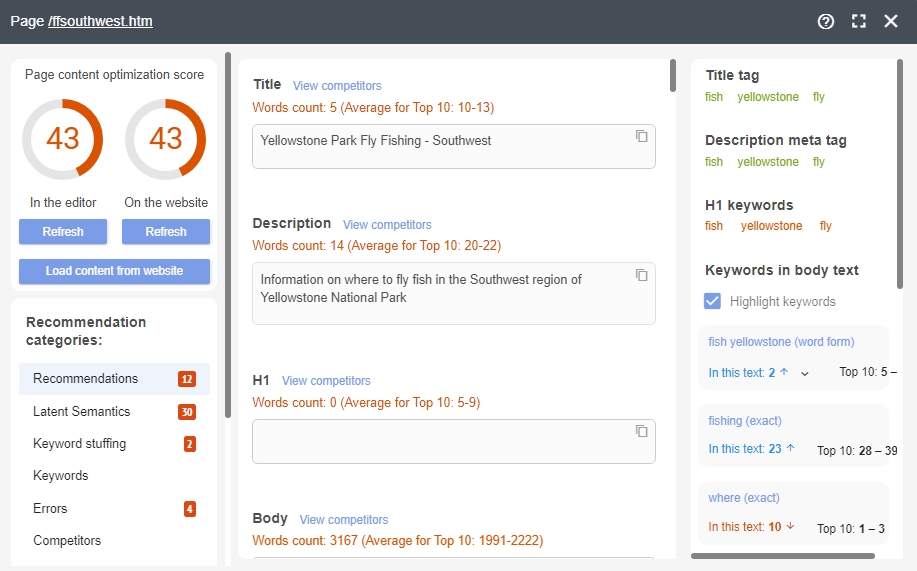
Labrika’s Guide to Avoiding Keyword Stuffing in SEO
Strategic keyword usage is essential for driving targeted traffic through search engines. When aligned with content marketing strategies, well-placed keywords help search engines understand your page while simultaneously delivering value to readers. However, over-optimization through keyword stuffing remains a critical pitfall that can harm Google ranking factors and erode user trust.
Understanding Keyword Stuffing: Why It’s a Practice to Avoid

Keyword stuffing, also known as spamdexing, refers to the practice of forcibly repeating phrases to manipulate search engine rankings. This outdated tactic often overlooks the importance of content quality and readability, leading to several negative outcomes:
- Higher bounce rates as visitors quickly leave unusable content.
- Penalties from search engine algorithms, such as Google’s Panda update, which specifically targets low-quality content.
- Lower conversion rates due to a poor user experience, as users are less likely to engage with or trust content that feels forced or unnatural.
To avoid keyword stuffing, it is essential to focus on creating content that naturally integrates relevant terms while prioritizing the needs and preferences of your readers. [place for SEO penalty infographic]
Identifying Common Keyword Stuffing Tactics to Avoid
Recognizing harmful practices is the first step toward improving content quality. Here are some common keyword stuffing tactics to watch for:
- Exact-match phrases that are repeated unnaturally, making the text feel robotic.
- Hidden text achieved through matching background and foreground colors, which can mislead both users and search engines.
- Irrelevant keywords inserted into alt tags or meta descriptions, which can confuse search engine crawlers.
- Overloading local geographic terms in attempts to optimize for “near me” searches, which can dilute the relevance of your content.
Utilizing tools like Labrika’s SEO audit software can help identify over-optimized pages, allowing you to fix keyword stuffing issues before penalties occur. Regular audits are a proactive way to maintain the integrity of your content strategy.
Best Practices for Optimizing Content Without Resorting to Keyword Stuffing
1. Prioritize Semantic Relevance
Modern on-page SEO techniques emphasize context over keyword density. Instead of focusing solely on repeating keywords, consider using:
- Latent Semantic Indexing (LSI) keywords, which are related terms that add depth to your content. For example, if your primary keyword is “architecture,” relevant LSI keywords might include “design,” “materials,” and “construction.”
- Long-tail phrases that capture specific user intent, such as “best rich roast coffee in Chicago,” which can attract a more targeted audience.
- Synonyms and variations of your primary keywords to avoid repetitive exact-match terms, enhancing the natural flow of your writing.
2. Structure Content Strategically
Align your content marketing strategy with Google ranking factors by employing a well-structured approach:
- Assign one primary keyword per page to maintain focus and clarity.
- Include keywords in H1 tags, URLs, and meta descriptions to signal relevance to search engines.
- Utilize subheadings (H2 and H3 tags) to organize long-form content, making it more digestible for readers and improving the overall user experience.
[place for keyword placement diagram]
3. Monitor Keyword Density
While there is no perfect percentage for keyword density, experts generally recommend keeping primary keywords under 3% of total content. Additionally:
- Use secondary keywords sparingly to support your main topic without overwhelming the reader.
- Analyze top-ranking competitors for benchmarks on keyword usage and content length, allowing you to gauge what works in your niche.
Content Marketing Strategies to Boost Organic Rankings
Effective content marketing strategies blend SEO keyword optimization with audience-centric writing. Here are some actionable strategies to consider:
- Solve Problems: Identify and address user pain points that have been uncovered through thorough keyword research. By directly answering the questions and concerns of your audience, you create content that resonates and adds value.
- Enhance Readability: Improve user engagement by breaking up text with visuals, bullet points, and ample white space. This not only makes your content more appealing but also helps retain readers’ attention. Clear, concise writing is key to maintaining interest.
- Update Regularly: Refresh old posts to maintain content quality and relevance. Regular updates signal to search engines that your content is current and valuable, which can positively impact your rankings.
Key Takeaways for Sustainable SEO Success
To effectively avoid keyword stuffing while improving your website’s visibility, consider the following key takeaways:
- Utilize tools to conduct regular audits and fix keyword stuffing risks before they escalate into penalties. This proactive approach helps maintain the quality of your content.
- Ensure that your content aligns with search intent and enhances user experience, which is vital for retaining visitors and converting them into customers.
- Implement on-page SEO techniques holistically across all pages of your website to create a cohesive strategy that maximizes your search engine performance.
By combining these effective SEO practices with continuous website content optimization, you will build a foundation for sustainable organic growth without risking penalties from search engines.
The Importance of User Experience in SEO
While keyword optimization is crucial, it is equally important to prioritize user experience. Search engines like Google are increasingly focused on providing users with the best possible experience. Factors such as page loading speed, mobile-friendliness, and intuitive navigation play a significant role in determining your rankings. Here are some strategies to enhance user experience:
- Improve Page Load Speed: Ensure your website loads quickly to minimize bounce rates. Tools like Google PageSpeed Insights can help identify areas for improvement.
- Mobile Optimization: With a significant amount of web traffic coming from mobile devices, having a responsive design is essential. Ensure your content is easily accessible on all screen sizes.
- Clear Navigation: A well-structured website makes it easier for users to find the information they need. Use a logical hierarchy in your menus and include a search function.
Leveraging Analytics for Continuous Improvement
Analytics tools provide valuable insights into how users interact with your content. By analyzing data, you can identify trends, understand user behavior, and make informed decisions about your content marketing strategies. Here are some ways to leverage analytics:
- Track User Engagement: Monitor metrics such as time on page, bounce rate, and click-through rate to gauge how well your content resonates with your audience.
- Identify Top-Performing Content: Use analytics to determine which pieces of content drive the most traffic and conversions. This information can guide your future content creation efforts.
- Adjust Strategies Based on Data: Be willing to adapt your content marketing strategies based on the insights you gather. If certain keywords or topics are underperforming, consider revising your approach.
Building Authority and Trust Through Quality Content
Establishing authority and trust is crucial for long-term success in SEO. High-quality content that provides real value to readers will not only improve your rankings but also foster loyalty among your audience. Here are some strategies to build authority:
- Focus on Original Research: Conducting original research or case studies can set your content apart from competitors and position you as an authority in your field.
- Engage with Your Audience: Encourage comments and feedback on your content. Engaging with your audience builds community and trust, which can enhance your brand’s reputation.
- Utilize Guest Posting: Writing guest posts for reputable sites in your industry can help you reach a broader audience and establish credibility.
Conclusion: The Path to Effective SEO
In conclusion, avoiding keyword stuffing is essential for maintaining content quality and achieving sustainable SEO success. By adopting effective SEO practices, prioritizing user experience, leveraging analytics, and building authority through valuable content, you can enhance your website's visibility and drive organic traffic over the long term. Remember, SEO is not just about optimizing for search engines; it’s about creating a meaningful experience for your users.
As you refine your content marketing strategies, keep in mind that the ultimate goal is to provide value to your audience. By focusing on their needs and preferences, you will not only improve your content but also foster a loyal readership that trusts your brand. This trust translates into higher engagement rates, better conversion rates, and ultimately, improved rankings on search engine results pages (SERPs).
As you embark on your SEO journey, remember that effective SEO is a continuous process. It requires regular updates, adjustments based on performance data, and a commitment to quality. By embracing these principles, you will create a robust online presence that stands the test of time.
In summary, to avoid keyword stuffing while enhancing your SEO efforts, focus on:
- Creating high-quality, valuable content that meets the needs of your audience.
- Utilizing strategic keyword placement that enhances readability rather than detracting from it.
- Regularly auditing your content to identify and address any potential SEO pitfalls.
- Engaging with your audience to build trust and authority in your niche.
- Continuously refining your strategies based on analytics and user feedback.

By following these guidelines and committing to ongoing website content optimization, you will not only avoid keyword stuffing but also position your brand for long-term success in the competitive digital landscape. Embrace the journey of learning and adapting, and remember that the core of effective SEO lies in connecting with your audience while achieving your business goals.
